Dino World
Welcome to DinoWorld! Click and dive into the past, exploring the amazing history of dinosaurs. Our search engine helps you find any dinosaur you can imagine. Let's journey together!
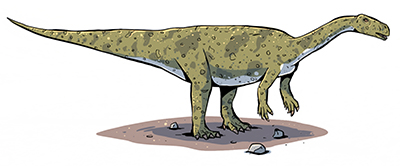
Type: prosauropod
Length: 8m
Diet: herbivorous
When Lived: Early Jurassic, 199-189 million years ago
Found In: South Africa
Named By: Yates, Bonnan, Neveling, Chinsamy and Blackbeard 2010 (2009)
Type Species: celestae
Description: Aardonyx is known from 2 immature individuals. Adults would have been much larger, probably over 10m.Aardonyx would have been largely bipedal (walking on 2 legs) but also capable of walking on all 4 legs. This and its way of feeding are transitional features between those of basal sauropodomorphs and the more derived sauropods (large dinosaurs that walked on all fours) that came later.

Type: large theropod
Length: 9m
Diet: carnivorous
When Lived: Late Cretaceous, 74-70 million years ago
Found In: Argentina
Named By: Bonaparte and Novas (1985)
Type Species: comahuensis
Description: This dinosaur has no description.

Type: ceratopsian
Length: 6m
Diet: herbivorous
When Lived: Late Cretaceous, 83-70 million years ago
Found In: USA
Named By: Sampson (1995)
Type Species: horneri
Description: This dinosaur has no description.
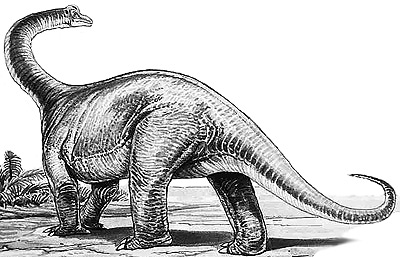
Type: sauropod
Length: 15m
Diet: herbivorous
When Lived: Late Cretaceous, 98-93 million years ago
Found In: Egypt
Named By: Stromer (1932)
Type Species: baharijensis
Description: This dinosaur has no description.
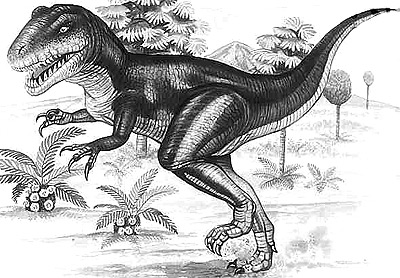
Type: large theropod
Length: 9m
Diet: carnivorous
When Lived: Early Cretaceous, 132-121 million years ago
Found In: Niger
Named By: Sereno, Wilson, Larsson, Dutheil and Sues (1944)
Type Species: abakensis
Description: This dinosaur has no description.

Type: sauropod
Length: 21m
Diet: herbivorous
When Lived: Late Cretaceous, 70-66 million years ago
Found In: USA
Named By: Gilmore (1922)
Type Species: sanjuanensis
Description: This is the only Late Cretaceous sauropod that has been found in North America.
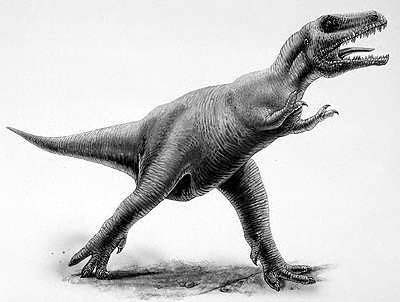
Type: large theropod
Length: 9m
Diet: carnivorous
When Lived: Late Cretaceous, 76-74 million years ago
Found In: Canada
Named By: Lamb (1914)
Type Species: libratus
Description: Albertosaurus was a close relative of Tyrannosaurus, but smaller and not as heavily built.
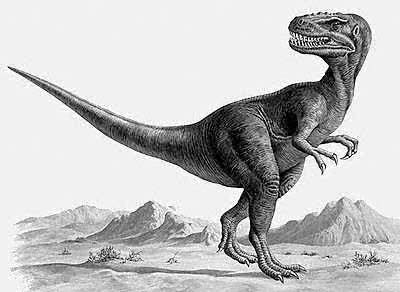
Type: large theropod
Length: 5m
Diet: carnivorous
When Lived: Late Cretaceous, 90-70 million years ago
Found In: China, Mongolia
Named By: Gilmore (1933)
Type Species: olseni
Description: This dinosaur has no description.
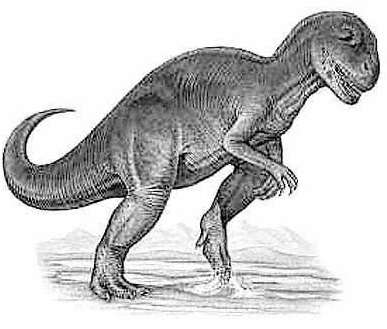
Type: large theropod
Length: 12m
Diet: carnivorous
When Lived: Late Jurassic, 152-145 million years ago
Found In: Portugal, USA
Named By: Marsh (1877)
Type Species: fragilis
Description: The teeth of Allosaurus were 5-10cm long and curved backwards to prevent prey from escaping.

Type: small theropod
Length: 2m
Diet: carnivorous
When Lived: Late Cretaceous, 89-85 million years ago
Found In: Argentina
Named By: Bonaparte (1991)
Type Species: calvoi
Description: Alvarezsaurus may have been feathered.
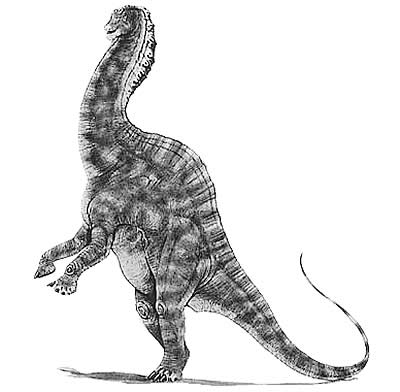
Type: sauropod
Length: 12m
Diet: herbivorous
When Lived: Early Cretaceous, 132-127 million years ago
Found In: Argentina
Named By: Salgado and Bonaparte (1991)
Type Species: cazaui
Description: This dinosaur had a double row of spines along its back which may have supported a twin 'sail' of skin. The spines on its neck vertebrae were incredibly long.

Type: prosauropod
Length: 5m
Diet: herbivorous
When Lived: Early Jurassic, 195-180 million years ago
Found In: USA
Named By: Marsh (1891)
Type Species: major
Description: This dinosaur was very similar to Anchisaurus.
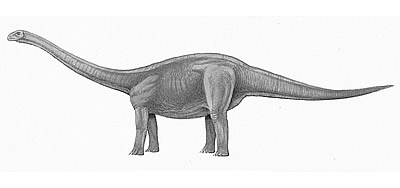
Type: sauropod
Length: 15m
Diet: herbivorous
When Lived: Mid Jurassic, 177-169 million years ago
Found In: Argentina
Named By: Cabrera (1947)
Type Species: patagonicus
Description: Amygdalodon is known from a single partial skeleton.
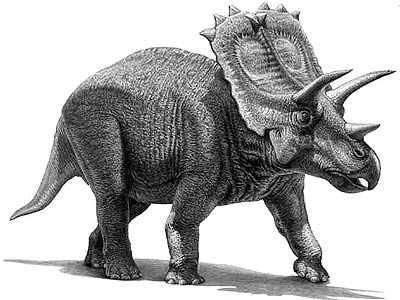
Type: ceratopsian
Length: 6m
Diet: herbivorous
When Lived: Late Cretaceous, 74-70 million years ago
Found In: Canada
Named By: Brown (1914)
Type Species: ornatus
Description: This dinosaur has no description.

Type: prosauropod
Length: 2m
Diet: herbivorous
When Lived: Early Jurassic, 190 million years ago
Found In: USA
Named By: Marsh (1885)
Type Species: polyzelous
Description: This dinosaur has no description.

Type: armoured dinosaur
Length: 8m
Diet: herbivorous
When Lived: Late Cretaceous, 68-66 million years ago
Found In: Canada, USA
Named By: Brown (1908)
Type Species: magniventris
Description: Ankylosaurus lived during the Late Cretaceous Period in what is now North America. This armoured dinosaur had bony plates covering its body and a heavy club at the end of its tail.Though it's the most famous member of the ankylosaur group, it's not the best understood. Scientists still haven't found an entire Ankylosaurus skeleton. Some other types of ankylosaurs, such as Zuul, are known from many more bones.But we do have enough Ankylosaurus remains to see that it may have been one of the biggest ankylosaurs.The first Ankylosaurus bones were found in 1906 at the Hell Creek Formation in Montana, USA. Barnum Brown led the fossil hunting trip - the same scientist who led the discovery of Tyrannosaurus rex a few years earlier.These Ankylosaurus fossils weren't very complete. The distinctive tail club wasn't discovered until much later.Barnum and his team found several pieces of armour, but they had separated from the main skeleton. Even today, nobody knows exactly how Ankylosaurus' back armour should be arranged.We can't say for sure how any dinosaur behaved when it was alive. Scientists can only go on fossils and comparisons with living animals.We know that as a plant eater, Ankylosaurus wouldn't have used its tail club to attack prey. It probably used the club to defend itself against big predators.Being herbivorous doesn't mean Ankylosaurus was harmless. Many modern plant-eating animals, such as elephants and hippos, can be very aggressive and dangerous. We may never know whether Ankylosaurus was gentle in nature!This hefty dinosaur probably moved very slowly most of the time, although it might have been able to move faster when needed.Ankylosaurus probably couldn't move its tail club up and down much, but could swing it powerfully from side to side - delivering devastating swipes to any would-be predators.Experts think Ankylosaurus grazed on low-growing plants. It probably wasn't picky - eating many kinds of ferns, shrubs and fruit.Ankylosaurus would've needed to eat around 60 kilogrammes of plant matter a day. That's about the same as a modern elephant.Some scientists think Ankylosaurus might have been able to use its front limbs for digging. If so, perhaps it also ate roots and any other kinds of plant and animal matter it could dig up.Several members of the ankylosaur group lacked the bony tail clubs seen in Ankylosaurus and others such as Tarchia, but were otherwise still covered in armour.These clubless ankylosaurs include Nodosaurus, Panoplosaurus and the British dinosaur Polacanthus.

Type: large theropod
Length: 3.5m
Diet: carnivorous
When Lived: Late Cretaceous, 84-66 million years ago
Found In: Mongolia
Named By: Barsbold (1988)
Type Species: planinychus
Description: This dinosaur has no description.
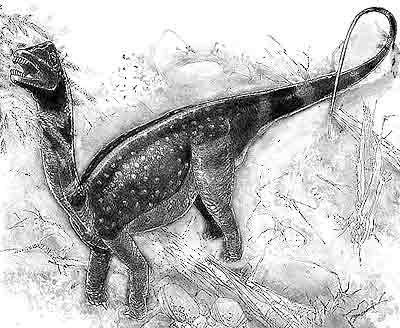
Type: sauropod
Length: 18m
Diet: herbivorous
When Lived: Late Cretaceous, 84 million years ago
Found In: Argentina, Chile, Uruguay
Named By: von Huene (1929)
Type Species: wichmannianus
Description: This dinosaur has no description.

Type: sauropod
Length: 21m
Diet: herbivorous
When Lived: Late Jurassic, 152-145 million years ago
Found In: USA
Named By: Marsh (1877)
Type Species: ajax
Description: Apatosaurus was a large sauropod dinosaur. It lived around 150 million years ago in the Late Jurassic Period, in an area that is now North America.Like all sauropods, Apatosaurus ate plants.Young Apatosaurus individuals grew up quickly. They took around 10 years to reach full adult size.Apatosaurus lived alongside Stegosaurus, Diplodocus and Allosaurus.Their fossils were found in the Morrison Formation, a sequence of rocks that covers a huge area spanning several US states, including Wyoming, Colorado and Montana. Many dinosaurs have been discovered there.During the Late Jurassic the environment was semi-arid, with forests, rivers and floodplains. There were distinct wet and dry seasons.Apatosaurus had a long, narrow tail that it might have used as a whip.The animal's huge size would also have helped to protect it from smaller predators, which may have found Apatosaurus too big to take on. Living in herds gave extra protection.The name Apatosaurus comes from Greek words meaning 'deceptive lizard'. The scientist who named this dinosaur, Othniel Charles Marsh, felt that some of the fossil bones were confusing to identify. They seemed to resemble the bones of a sea reptile.For more than 100 years, most scientists stopped using the well-known dinosaur name Brontosaurus. They thought that Brontosaurus and Apatosaurus fossils were the same thing.But based on a study done in 2015, experts now think that the two dinosaurs are separate after all, although they are closely related.Apatosaurus went extinct 145 million years ago, at the end of the Jurassic Period.

Type: large ornithopod
Length: 8m
Diet: herbivorous
When Lived: Late Cretaceous, 94-84 million years ago
Found In: Kazakhstan
Named By: Rozhdestvensky (1968)
Type Species: tuberiferus
Description: This dinosaur has no description.